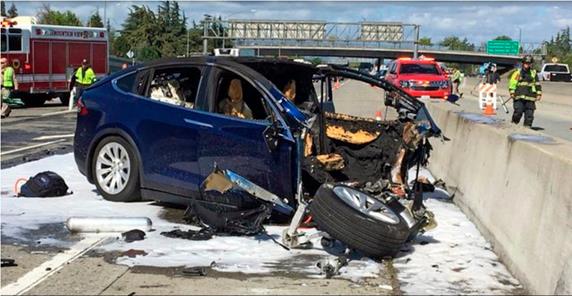The promise of self-driving technology has long fascinated the world, offering visions of safer roads, fewer accidents, and a future free from human error. However, incidents like the one captured in this image serve as stark reminders of the challenges that remain in autonomous AI development.
What Happened?
The image above depicts the aftermath of a severe crash involving an autonomous vehicle, where the car has suffered extensive damage, possibly after a high-speed collision. The front end is completely obliterated, with its internal structure exposed and burned. Firefighters and emergency responders in the background emphasize the serious nature of the accident.
While the exact details of this particular crash require official confirmation, similar incidents have occurred where vehicles operating on autonomous or semi-autonomous systems have crashed into highway barriers, other vehicles, or stationary objects.
Autonomous Driving: Innovation vs. Risk
Self-driving technology relies on advanced sensors, cameras, and artificial intelligence to navigate roads, maintain speed, and avoid obstacles. However, most systems available today still require human supervision. Despite warnings that drivers must remain attentive, multiple crashes have raised concerns about over-reliance on autonomous features.
The Safety Debate: Who’s at Fault?
Manufacturers argue that autonomous systems are meant to assist rather than replace human drivers. However, critics claim that branding and marketing often mislead users into overestimating the technology’s capabilities. Regulatory bodies continue to investigate the role of self-driving features in accidents, questioning whether current AI safety measures are sufficient.
Let’s apply this to AI Agents…
AI Agents Without Human Oversight: A Recipe for Disaster
The rapid advancement of artificial intelligence has led to incredible innovations, from self-driving cars to AI-powered medical diagnoses. However, as AI systems become more autonomous, a critical question arises—what happens when AI operates without human oversight? The answer, as history has shown, can range from minor inconveniences to catastrophic failures.
The Dangers of AI Without Human Control
AI Agents are designed to process vast amounts of data, recognize patterns, and make decisions at speeds beyond human capability. However, one critical element is missing—human judgment. Without human intervention, AI Agents can make errors that may lead to dangerous outcomes.
Why Human Oversight is Essential
Despite AI’s potential, one truth remains: AI must serve humanity, not replace human decision-making. Here’s why human intervention is non-negotiable:
- Ethical Decision-Making – AI lacks moral reasoning—humans must guide it to ensure fair and ethical outcomes.
- Error Prevention – AI can make mistakes; human oversight acts as a safeguard against catastrophic failures.
- Accountability – Without human intervention, who is responsible when AI goes wrong? AI must remain under human control to ensure accountability.
- Adaptability – AI struggles with nuance and context—humans provide the judgment and flexibility that machines lack.
Conclusion: The Need for Responsible AI
AI is a powerful tool, but without human intervention, it can quickly turn from an asset into a disaster. The key is to strike a balance—leveraging AI’s efficiency while maintaining human control over critical decisions. The future of AI should be one where it empowers humans, not replaces them. That’s the only way to ensure a safer and more responsible technological future. That’s what we specialize in EvoAuto!


